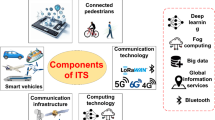Abstract
In this paper, we examine an algorithm for estimating the location of packet collisions, in the presence of bandlimited multipath channels. We propose an improvement to the collision localization algorithm to further enhance its performance to compensate for the increased impairments of the multipath channel. We then examine the collision localization algorithm in conjunction with two common wireless LAN standards, 802.11b and 802.11a/g. We show that for the 802.11b standard, the collision localization algorithm performs well, even in the presence of a multi-path channel. We also show that the 802.11 a/g standards are compatible with collision localization. However, we will see that the IFFT/FFT operations required to perform OFDM transmission limit the effectiveness of collision localization. We therefore also investigate collision localization in conjunction with block-based single carrier transmission, a comparable technology to OFDM, and offers some advantages when used with collision localization. In addition, we also investigate two applications of collision localization. First, we will show that collision localization in conjunction with Viterbi decoding with erasures can, in many cases, allow for corrupted packets to be completely recovered at the receiver. Second, we will also demonstrate that collision localization can be used to combat narrow-band interference, such as Bluetooth, in 802.11 a/g networks.
Similar content being viewed by others
References
Toh C.-K., Delwar M., Allen D. (2002) Evaluating the communication performance of ad hoc wireless network. IEEE Transaction on Wireless Communications 1: 402–414
Kleinrock, L., & Tobagi, F. A. (1975). Packet switching in radio channels: Part I—Carrier sense multiple access modes and their throughput-delay characteristics. In IEEE Transactions on Communications (pp. 1400–1416).
Ray S., Carruthers J. B., Starobinski D. (2005) Evaluation of the masked node problem in ad-hoc wireless LANs. IEEE Transactions on Mobile Computing 4: 430–432
Srivastava V., Motani M. (2005) Cross-layer design: A survey and the road ahead. IEEE Communications Magazine 43: 112–119
Hadzi-Velkov Z., Spasenovsk B. (2003) An analysis of CSMA/CA protocol with capture in wireless LANs. Wireless Communications and Networking Conference 2: 1303–1307
Tsatsanis M. K., Zhang R., Banerjee S. (2000) Network-assisted diversity for random access wireless networks. IEEE Transactions on Signal Processing 48: 702–711
Wang X., Orchard M. T. (2003) On reducing the rate of retransmission in time-varying channels. IEEE Transcations on Communications 51: 900–910
Zhang R., Sidiroplous N. D., Tsatsanis M. K. (2002) Collision resolution in packet radio networks using rotational invariance techniques. IEEE Transactions on Communications 50: 146–155
Wang Z., Liu L., Zhou M. (2007) Space and network diversity combination for masked node collision resolution in wireless ad hoc network. IEEE Transactions on Wireless Communications 6: 478–485
Kwon Y., Fang Y., Latchman H. (2004) Design of MAC protocols with fast collision resolution for wireless local area networks. IEEE Transactions on Wireless Communications 3: 793–807
Wang C., Li B., Li L. (2004) A new collision resolution mechanism to enhance the performance of the IEEE 802.11 DCF, d. IEEE transactions on vehicular technology 53: 1235–1246
Zhou, Y., & Wang, J. (2006). Optimum subpacket transmission for hybrid ARQ systems. In IEEE transactions on communications (pp. 934–942).
Gollakota, S., & Katabi, D. (2008). Zigzag decoding: Combating hidden terminals in wireless networks, SIGCOMM ’08.
Lin, K. C.-J., Kushman, N., & Katabi, D. (2008). Ziptx: Harnessing partial packets in 802.11 networks, MOBICOM ’08.
Wang Z., Ma X., Giannakis B., Giannakis B. (2004) OFDM or single-carrier block transmissions?. IEEE Transactions on Communications 3: 380–394
Keene, S., & Carruthers, J. B. (2009). Collision and fade localization within packets for wireless lans, Wireless Personal Communications.
Keene, S., & Carruthers, J. B. (2007). Improved error correction in wireless lans using erasures decoding with collision localization. In Proceedings of IEEE global telecommunications conference (pp. 4451–4455).
I. W. Group (2007). IEEE 802.11-2007: Wireless LAN medium access control (MAC) and physical layer (PHY) specifications. In IEEE.
Sari H., Karam G., Jeanclaude I. (1995) Transmission techniques for digital terrestrial tv broadcasting. IEEE Communications Magazine 33: 100–109
Goldsmith A. (2005) Wireless commuications. Cambridge University Press, 40 West 20th Street, New York NY 10011
B. S. I. Group, (1999). Specification of the Bluetooth System. Available at www.bluetooth.com.
Ghosh, M., & Gadam, V. (2003). Bluetooth interference cancellation for 802.11g WLAN receivers, Communications, 2003. ICC ’03. In IEEE international conference on, vol 2 (pp. 1169–1173).
Author information
Authors and Affiliations
Corresponding author
Rights and permissions
About this article
Cite this article
Keene, S.M., Carruthers, J.B. Collision Localization for IEEE 802.11 Wireless LANs. Wireless Pers Commun 63, 45–63 (2012). https://doi.org/10.1007/s11277-010-0107-4
Published:
Issue Date:
DOI: https://doi.org/10.1007/s11277-010-0107-4




